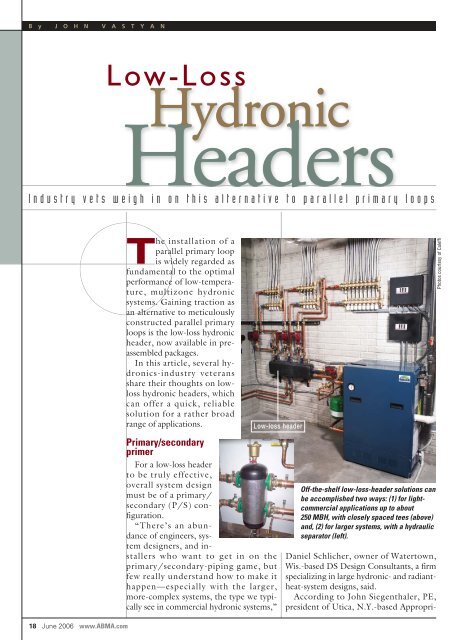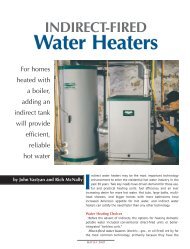article about low loss headers - Common Ground
article about low loss headers - Common Ground
article about low loss headers - Common Ground
You also want an ePaper? Increase the reach of your titles
YUMPU automatically turns print PDFs into web optimized ePapers that Google loves.
B y J O H N V A S T Y A N<br />
18 June 2006 www.ABMA.com<br />
Low-Loss<br />
Hydronic<br />
Headers<br />
Industry vets weigh in on this alternative to parallel primary loops<br />
The installation of a<br />
parallel primary loop<br />
is widely regarded as<br />
fundamental to the optimal<br />
performance of <strong>low</strong>-temperature,<br />
multizone hydronic<br />
systems. Gaining traction as<br />
an alternative to meticulously<br />
constructed parallel primary<br />
loops is the <strong>low</strong>-<strong>loss</strong> hydronic<br />
header, now available in preassembled<br />
packages.<br />
In this <strong>article</strong>, several hydronics-industry<br />
veterans<br />
share their thoughts on <strong>low</strong><strong>loss</strong><br />
hydronic <strong>headers</strong>, which<br />
can offer a quick, reliable<br />
solution for a rather broad<br />
range of applications.<br />
Low-<strong>loss</strong> header<br />
Primary/secondary<br />
primer<br />
For a <strong>low</strong>-<strong>loss</strong> header<br />
to be truly effective,<br />
overall system design<br />
must be of a primary/<br />
secondary (P/S) configuration.<br />
“There’s an abundance<br />
of engineers, system<br />
designers, and installers<br />
who want to get in on the<br />
primary/secondary-piping game, but<br />
few really understand how to make it<br />
happen—especially with the larger,<br />
more-complex systems, the type we typically<br />
see in commercial hydronic systems,”<br />
Off-the-shelf <strong>low</strong>-<strong>loss</strong>-header solutions can<br />
be accomplished two ways: (1) for lightcommercial<br />
applications up to <strong>about</strong><br />
250 MBH, with closely spaced tees (above)<br />
and, (2) for larger systems, with a hydraulic<br />
separator (left).<br />
Daniel Schlicher, owner of Watertown,<br />
Wis.-based DS Design Consultants, a firm<br />
specializing in large hydronic- and radiantheat-system<br />
designs, said.<br />
According to John Siegenthaler, PE,<br />
president of Utica, N.Y.-based Appropri-<br />
Photos courtesy of Caleffi
ate Designs, P/S piping has been<br />
used in the hydronic heating industry<br />
for decades. The closely spaced<br />
tees of <strong>low</strong>-<strong>loss</strong> hydronic <strong>headers</strong>—<br />
or the closely spaced ports of parallel<br />
primary loops—couple each secondary<br />
circuit to a common primary,<br />
al<strong>low</strong>ing circulators of different<br />
pumping to co-exist in the same<br />
system without interfering with one<br />
another. Each circuit functions<br />
singularly, with no real connection<br />
to the other circuits.<br />
“You might even say that a circulator<br />
in a given circuit of a P/S system<br />
doesn’t know the other circulators<br />
and piping circuits even exist,”<br />
Siegenthaler said.<br />
With P/S piping, the ability to<br />
isolate system circuits makes designing<br />
sophisticated multiload systems<br />
relatively easy, without concern for<br />
how f<strong>low</strong> rates and pressure drops<br />
will change as circulators turn on<br />
and off, Siegenthaler said. This is a<br />
considerable benefit because, otherwise,<br />
circuits would compete with<br />
one another for fluid f<strong>low</strong>, greatly<br />
complicating heat distribution.<br />
Dan Foley, president of Alexan-<br />
dria, Va.-based Foley Mechanical,<br />
said that when a P/S system is piped<br />
in the field, there always is the risk<br />
of the “cascade effect,” with each<br />
successive set of tees “seeing” a<br />
<strong>low</strong>er temperature.<br />
“Yet, with a <strong>low</strong>-<strong>loss</strong> header, each<br />
supply tapping receives the same<br />
temperature,” Foley said.<br />
Although P/S piping is best<br />
suited to more-complex multiload,<br />
multitemperature systems, its applicability<br />
can extend to simpler hy-<br />
“There’s an abundance of engineers, system<br />
designers, and installers who want to get in on the<br />
primary/secondary-piping game, but few really<br />
understand how to make it happen.”<br />
—Daniel Schlicher, DS Design Consultants<br />
Circle 13<br />
dronic systems, Siegenthaler said.<br />
Finessing the design<br />
Series primary loops are best<br />
suited to situations in which two<br />
or more secondary loads operate<br />
with different supply temperatures,<br />
Siegenthaler said, adding that the<br />
BSE June 2006 19
Circle 20<br />
20 June 2006 www.ABMA.com<br />
L O W - L O S S H Y D R O N I C H E A D E R S<br />
basic principle is to connect the<br />
higher-temperature secondary<br />
circuits near the beginning of a<br />
primary loop to the <strong>low</strong>er-temperature<br />
secondary circuits near the end.<br />
This arrangement, Dave Yates,<br />
owner of York, Pa.-based F.W.<br />
Behler Inc., said, tends to increase<br />
the temperature drop along the<br />
primary loop, reducing f<strong>low</strong> rate.<br />
An added benefit is that it may<br />
permit a reduction in the size of the<br />
primary loop’s piping and circulator(s).<br />
Sensible modifications of<br />
this basic design will accommodate<br />
any number of secondary circuits,<br />
permitting them to operate at similar<br />
supply temperatures.<br />
Out-of-the-box solution<br />
Combining a hydraulic separator<br />
and distribution manifold, <strong>low</strong>-<strong>loss</strong><br />
<strong>headers</strong> typically are attached to<br />
a hydronic-heating or chilled-water<br />
system, permitting different heat<br />
adjustments for multiple separate<br />
zones when there is only one boiler<br />
or chiller.<br />
Low-<strong>loss</strong>-header configurations<br />
typically are compact and easily<br />
can be designed into any type of<br />
hydronic circuit. The primary operating<br />
principle is this: When a system<br />
does not contain a means of<br />
hydraulic separation between loops<br />
with separately sized circulators, the<br />
possibility of a tug of war between<br />
the circulators is created, which<br />
could lead to unexpected f<strong>low</strong> problems.<br />
The key function of a <strong>low</strong>-<strong>loss</strong><br />
header is to provide a <strong>low</strong>-pressure<strong>loss</strong><br />
zone enabling both primary and<br />
secondary circuits to be hydraulically<br />
independent of one another.<br />
This is critical to the new generation<br />
of high-f<strong>low</strong>-resistant, <strong>low</strong>-mass<br />
condensing-boiler installations<br />
because the point of <strong>low</strong>est pressure<br />
drop is moved from the boiler to<br />
the header’s <strong>low</strong>-pressure chamber.<br />
The closely spaced tees of the<br />
distribution manifold connect the<br />
secondary circuit to the primary<br />
Bob Rohr of Show Me Radiant Heat<br />
connects circulators to a <strong>low</strong>-<strong>loss</strong><br />
header.<br />
loop internally so that f<strong>low</strong> in the<br />
primary loop has little or no influence<br />
on f<strong>low</strong> in the secondary<br />
circuit, preventing pump conflict<br />
and the thorny dilemma of having<br />
different loop delta-Ps.<br />
“Because the openings in the primary<br />
chamber are so close together,<br />
there is almost no pressure difference<br />
between them, and so the pressure<br />
differential across the internal<br />
<strong>headers</strong> is close to zero,” Roger<br />
Michaud, national sales manager for<br />
hydronic-systems supplier Caleffi,<br />
said. “The pressure increase created<br />
by a given zone circulator is almost<br />
entirely depleted by the time the<br />
f<strong>low</strong> returns back to the distribution<br />
manifold. This arrangement prevents<br />
interference between the<br />
boiler circulator and whatever zone<br />
circulators are operating. It’s easy<br />
for system designers or installers<br />
to think that isolating the primary<br />
loop is the only thing that needs to<br />
be done.”<br />
Bob Rohr, owner of Rogersville,<br />
Mo.-based Show Me Radiant Heat,<br />
said: “There’s no question copper<br />
pipe and fittings can be used to<br />
build <strong>low</strong>-<strong>loss</strong> <strong>headers</strong>, but a manufactured<br />
<strong>low</strong>-<strong>loss</strong> header greatly<br />
Photo courtesy of Caleffi/Grundfos
L O W - L O S S H Y D R O N I C H E A D E R S<br />
simplifies the<br />
process, reduces<br />
labor<br />
FIGURE 1.<br />
Multiple-load,<br />
light-commercial<br />
design using a<br />
<strong>low</strong>-<strong>loss</strong> header.<br />
An additional<br />
circulator is not<br />
needed because<br />
the boiler has an<br />
internal<br />
circulator.<br />
Previously, one<br />
boiler was<br />
installed chiefly<br />
for domesticwater<br />
needs.<br />
Once the wholebuilding<br />
remodel<br />
was under way,<br />
the system<br />
quickly grew<br />
beyond its ability<br />
to provide heat.<br />
22 June 2006 www.ABMA.com<br />
Circle 14
L O W - L O S S H Y D R O N I C H E A D E R S<br />
cost and time,<br />
and, most importantly,<br />
gets<br />
it done correctly.”<br />
“If you talk<br />
to engineers<br />
and installers<br />
<strong>about</strong> hydronic<br />
systems, as I do<br />
on a regular basis,<br />
you’ll soon<br />
FIGURE 2. Here, a<br />
hydraulic<br />
separator serves<br />
as a high-volume,<br />
<strong>low</strong>-<strong>loss</strong> header<br />
for a three-boiler,<br />
600-MBH system<br />
that includes an<br />
indirect-fired<br />
water heater,<br />
which becomes<br />
the domestic<br />
buffer tank.<br />
24 June 2006 www.ABMA.com<br />
Circle 23 Circle 22
L O W - L O S S H Y D R O N I C H E A D E R S<br />
learn <strong>about</strong> plenty of ‘missed’ P/S<br />
and header attempts,” Schlicher<br />
added. “It’s not as easy as soldering<br />
pipe to build the proper header or<br />
P/S loop. You need to know how<br />
to go <strong>about</strong> it. And, modern highhead<br />
condensing boilers pretty<br />
much dictate the need for these.”<br />
26 June 2006 www.ABMA.com<br />
Circle 16<br />
Harold Kestenholz, who trained<br />
thousands of installers during his<br />
many years as an instructor with<br />
the Hydronics Institute, said that<br />
while, “A <strong>low</strong>-<strong>loss</strong>-header layout<br />
is great for commercial buildings<br />
over 300,000 Btuh, ... for some<br />
smaller or simpler applications,<br />
it’s overkill.”<br />
“There simply isn’t enough complicated<br />
water f<strong>low</strong> in some systems<br />
to install a <strong>low</strong>-<strong>loss</strong> header,” Kestenholz<br />
explained. “All that some<br />
systems require is a header to be<br />
made up of a foot of 1-in. copper<br />
with two tees.<br />
“A successful installation,”<br />
Kestenholz continued, “will happen<br />
when the supply and return piping<br />
near the boiler differ by <strong>about</strong> 20 F<br />
on a thermometer. This will be the<br />
same whether the boiler is or is not<br />
condensing.”<br />
Siegenthaler agreed: “I see where<br />
Harold is coming from. For example,<br />
he says a simple three-zone<br />
system with three pumped zone<br />
circuits all operating at the same<br />
temperature and supplied by a boiler<br />
with <strong>low</strong> f<strong>low</strong> resistance can operate<br />
just fine if coupled with a properly<br />
sized header system. Could it operate<br />
with a <strong>low</strong>-<strong>loss</strong> header? Yes, but<br />
an additional circulator would be<br />
needed (Figure 1). This would also<br />
be true for a site-built primary/<br />
secondary system. The additional<br />
circulator does add to installation<br />
and operating cost, and our industry<br />
seems to have developed a habit of<br />
using lots of circulators that at some<br />
times are not necessary. I’m trying<br />
to get them to discern when P/S is<br />
necessary vs. when it could be done<br />
with more conventional header<br />
piping. Both methods definitely<br />
have their place.”<br />
When used with high-mass castiron<br />
or steel boilers, zero-balance<br />
manifolds save time and eliminate<br />
unexpected problems, Kestenholz<br />
said, adding he also favors their use<br />
with <strong>low</strong>-mass boilers.<br />
“My concern, chiefly with <strong>low</strong>mass<br />
boilers,” Kestenholz said, “is<br />
that the burner input be controlled<br />
to prevent overheating when only<br />
some zones are open. Here, the<br />
installer could create additional<br />
‘mass’ in the primary or bypass loop<br />
to absorb heat when only a few<br />
zones are open.”
L O W - L O S S H Y D R O N I C H E A D E R S<br />
The key challenge, of course, is<br />
that <strong>low</strong>-mass boilers do not have a<br />
place to put large heat inputs. If a<br />
boiler is sized improperly, this could<br />
lead to the overfiring of a building<br />
load and, as a result, hammering and<br />
sizzling—with or without a good<br />
bypass.<br />
28 June 2006 www.ABMA.com<br />
Circle 18<br />
“If you have a 300,000-Btuh<br />
copper-tube boiler, you’d better<br />
have some place to safely direct<br />
230,000 Btus right now,” Kestenholz<br />
said. “You don’t want 70,000<br />
Btus going into an indirect water<br />
heater with all the other zones shut<br />
off in the summer, unless you have<br />
some means to anticipate tube overheating<br />
right now. A zero-balance<br />
header assumes in its design that<br />
there will be multi zones, so only<br />
part of the input will be necessary.<br />
It’s also assumed that the installer<br />
understands the need to pipe the<br />
system to handle part loads when<br />
only one or few zones are open.<br />
“There’s no question,” Kestenholz<br />
continued, “that <strong>low</strong>-<strong>loss</strong><br />
<strong>headers</strong> are a useful and helpful<br />
device. I just wish there’d be a better<br />
way to tell newbies coming into the<br />
industry to make sure that users of<br />
zero-balance manifolds design their<br />
systems so that burner input doesn’t<br />
exceed terminal-unit output. That’s<br />
been a constant problem, one that<br />
even professional education hasn’t<br />
solved. Just using one of these<br />
devices provides easy—hopefully,<br />
pump-away—manifolding, air elimination,<br />
and expansion-tank fitting<br />
... while making unexpected f<strong>low</strong>s<br />
a thing of the past.”<br />
At the root of Kestenholz’s concern<br />
is the danger of too much heat<br />
being forced into a system that is illequipped<br />
to handle it. Kestenholz<br />
said simply controlled (non-modulating)<br />
<strong>low</strong>-mass boilers work well<br />
when applied to large masses, such<br />
as wide-open, single-zone systems<br />
with sufficient baseboard or panel<br />
radiation to emit heat or radiant<br />
slabs that can absorb heat.<br />
Modulating boilers can adjust<br />
downward to supply small matching<br />
loads. However, one- or two-stage<br />
burner input easily can exceed<br />
summer indirect-water-heater-only<br />
loads and staggered zone-opening<br />
loads. For installations such as these<br />
(Figure 2), Kestenholz recommends<br />
a buffer tank, perhaps an indirectfired<br />
water heater, to make domestic<br />
water, adding valuable mass to<br />
the water loop during operation of<br />
single- or two-stage boilers with<br />
only a few open zones (Figure 2).<br />
“Sufficient water mass permits<br />
some time for the controls to sense<br />
and shut down the burner, then ab-
Circle 26<br />
Circle 27<br />
30 June 2006 www.ABMA.com<br />
L O W - L O S S H Y D R O N I C H E A D E R S<br />
sorb the exchanger heat without having the water<br />
exceed safe boiler temperatures or pressure,” Kestenholz<br />
said. “Manifolds can be built to use the tank in<br />
the same manner as preassembled units, but the (manufactured<br />
units) get it done so much more effectively<br />
when mounted in such a way that all the boiler water<br />
also passes through the tank, as in a bypass or primary<br />
loop.”<br />
Conclusion<br />
Although a <strong>low</strong>-<strong>loss</strong> header is not the answer for<br />
every job, its applicability is rather broad. According to<br />
Mark Eatherton of Denver-based Advanced Hydronics<br />
Inc., it is easy to take a wrong turn when assembling<br />
a P/S layout—one small mistake can cause a substantial<br />
problem or at least create a situation in which<br />
system efficiency is reduced. Out of the box, however,<br />
a <strong>low</strong>-<strong>loss</strong> header can offer a quick, reliable solution.<br />
About the Author<br />
John Vastyan is a writer whose work has focused<br />
on the hydronics and HVAC industries for 20 years.<br />
He owns <strong>Common</strong> <strong>Ground</strong>, a trade-communications<br />
firm based in Manheim, Pa. He can be contacted at<br />
cground@ptd.net.<br />
Circle 25






